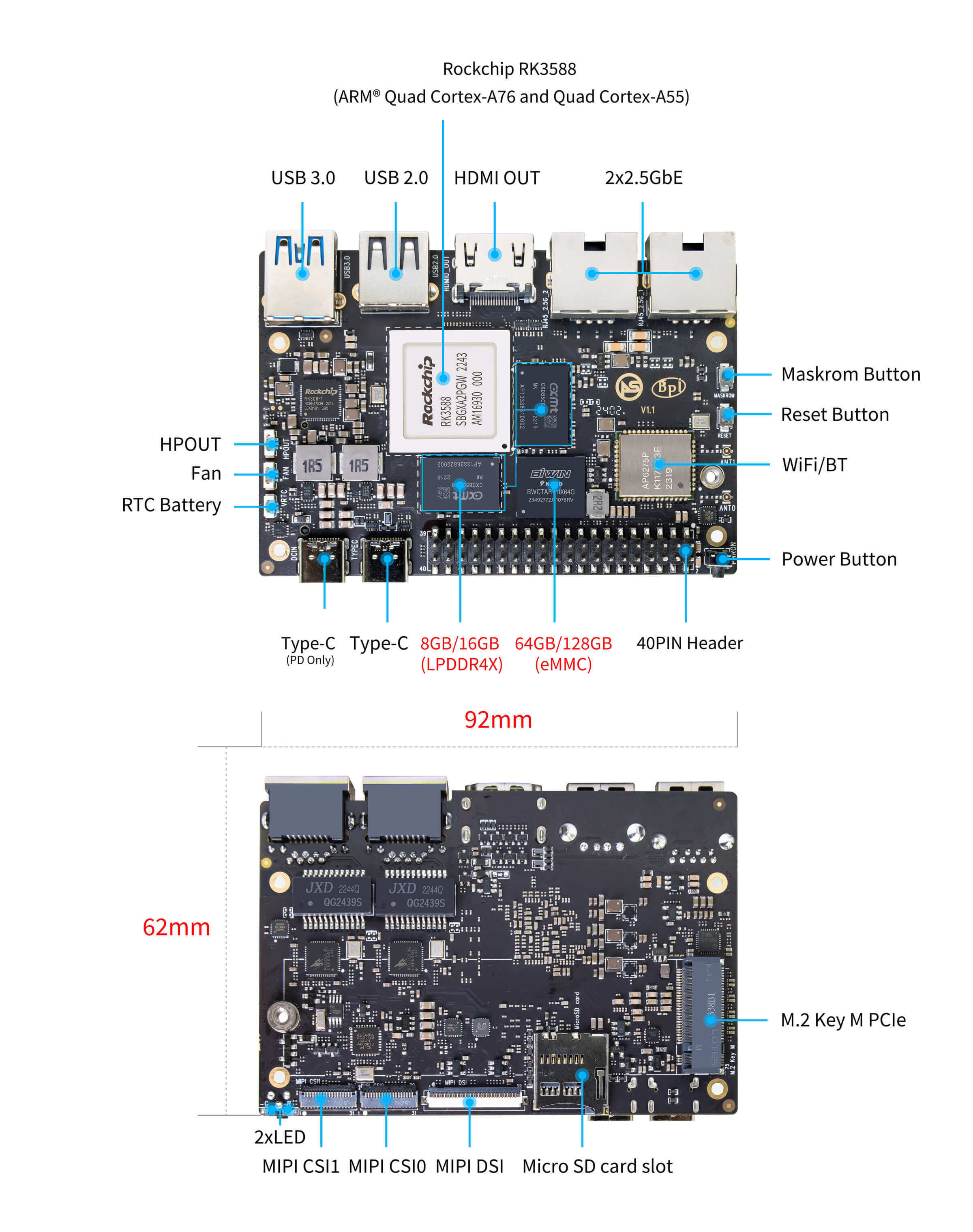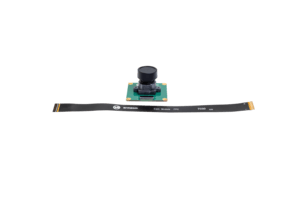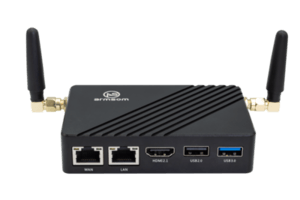Product Introduction: Sige7
Let's get to know Sige7 in 5 minutes.
Overview
The ArmSoM-Sige7 is powered by Rockchip's latest flagship RK3588,octa-core 64-bit processor, with a max frequency of 2.4GHz, a 6 TOPS NPU, and up to 32GB of RAM.

- ArmSoM-Sige7 AI SBC;
- ArmSoM-AIM7 AIM7 core board, ArmSoM-AIM-IO AIM Companion IO Board;
- ArmSoM-LM7 LGA core board, ArmSoM-W3 LGA core board maker kit;
With the powerful ecosystem and variety of extension modules, ArmSoM can help users easily go from ideas to prototype to mass production, making it an ideal creative platform for makers, dreamers and hobbyists.
Sige 7 is applied for various applications,such as, ARM PCs, edge computing, cloud servers, AI, cloud computing, virtual/augmented reality, blockchain, smart NVRs and more.
Key Parameter
- SoC: Rockchip RK3588
- CPU: 4x Cortex-A76 @ 2.4GHz + 4x Cortex-A55 @ 1.8GHz, 8nm
- GPU: ARM Mali-G610 MP4
- NPU: Up to 6 TOPS (INT8), supports INT4/INT8/INT16 mixed computing
- VPU/Codec:
- Hardware Decode: 8K@60fps H.265/VP9/AVS2, 8K@30fps H.264 AVC/MVC, 4K@60fps AV1, 1080P@60fps MPEG-2/-1/VC-1/VP8
- Hardware Encode: 8K@30fps H.265 / H.264
- RAM: 8GB/16GB/32GB (max 32GB) 64bit LPDDR4/LPDDR4x, default 8GB LPDDR4x
- Storage: 64GB/128GB eMMC, default 64GB eMMC
- WIFI/BT: IEEE 802.11a/b/g/n/ac/ax WIFI6 and BT5 AP6275P
- Operating Voltage: Wide input voltage, 5V to 20V (±5% tolerance)
- Operating temperature: 0°C ~ 80°C
- OS:
- Official: Android 12.0, Debian 11, Buildroot
- 3rd party: Armbian, Ubuntu 22.04, Ubuntu 24.04, Arch Linux, openSUSE
- PCB: 12-layer
- Weight: 46.6g
- Size: 92mm × 62mm x 14.6mm
Getting started
Sige User Manual
How to start using your Sige
Hardware
Hardware Interface


There are two identical Type-C ports on Sige7,but only the Type-C (PD Only) port is for power input.
Hardware Spec
Sige7 Hardware Spec
| Category | Functional Parameters |
|---|---|
| SOC | |
| CPU | |
| GPU | |
| NPU | |
| VPU/Codec | |
| ISP | |
| RAM | |
| Flash | |
| PCIe | |
| Networking | |
| Video Out | |
| Video In | |
| Audio | |
| USB | |
| 40-PIN | |
| Other | |
| Power Input | |
| Buttons | |
| OS Support | |
| Dimensions | |
| Operating temperature |
Comparison of Specifications for Sige7/5/3/1
| Sige7 | Sige5 | Sige3 | Sige1 | |
|---|---|---|---|---|
| SoC Process | 8nm | 8nm | 22nm | 28nm |
| CPU | Rockchip RK3588 Cortex-A76 x4 @2.4GHz and Cortex-A55 x4 @1.8GHz | Rockchip RK3576 Cortex-A72 x4 @2.2GHz and Cortex-A53 x4 @1.8GHz | Rockchip RK3568B2 Cortex-A55 x4 @2GHz | Rockchip RK3528 Cortex-A53 x4 @2GHz |
| GPU | ARM Mali-G610 MP4 | ARM Mali G52 MC3 GPU | Arm Mali‑G52‑2EE | ARM Mali-450 GPU |
| NPU | 6TOPS@INT8(3 NPU core) | 6TOPS@INT8(2 NPU core) | 1TOP@INT8 | - |
| RAM | 4GB/8GB/16GB/32GB 64-bit LPDDR4x | 4/8/16GB 32-bit LPDDR4x | 2/4GB 32-bit LPDDR4x | 2/4GB 32-bit LPDDR4x |
| eMMC | 64GB/128GB eMMC | 32/128GB eMMC | 32GB eMMC | 8 eMMC |
| TF Card | Molex Slot, Spec Version 2.x/3.x/4.x(SDSC/SDHC/SDXC) | Yes | Yes | Yes |
| Output | 1x HDMI 2.1, supports 8K@60fps 1x MIPI DSI up to 4K@60fps 1x DP 1.4 up to 8K@30fps | 1x HDMI 2.1, supports 4K@120fps 1x MIPI DSI, up to 2K@60fps 1x DP1.4, up to 4K@120fps | 1x MIPI DSI up to 2K@60fps 1x HDMI OUT2.0, supports 4K@60fps | 1x HDMI OUT2.0b, supports 4K@60fps |
| Decoder | 8K@60fps H.265/VP9/AVS2 8K@30fps H.264 AVC/MVC 4K@60fps AV1 1080P@60fps MPEG-2/-1/VC-1/VP8 | H.264, H.265, VP9, AV1 and AVS2 etc. up to 8K@30fps or4K@120fps | 4KP60 H.265/H.264/VP9 | H.265, H.264, AVS2 4K@60fps |
| Encoder | 8K@30fps H.265 / H.264 | H.264 and H.265 up to 4K@60fps | 1080P60 H.264/H.265 | H.264 and H.265 up to1080@60fps |
| Wi-Fi | AP6275P Wi-Fi 6 Module 802.11a/b/g/n/ac/ax, 2T2R MIMO with RSDB | SYN43752 Wi-Fi 6 Module 802.11a/b/g/n/ac/ax, 2T2R MIMO with RSDB | SYN43752 Wi-Fi 6 Module 802.11a/b/g/n/ac/ax, 2T2R MIMO with RSDBs | SYN43752 Wi-Fi 6 Module 802.11a/b/g/n/ac/ax, 2T2R MIMO with RSDBs |
| PCIE | PCIe 3.0 4-lanes M.2 Key M 2280 NVMe SSD Supported | PCIe 2.1 1-lanes M.2 Key M 2280 NVMe SSD Supported | PCIe 3.0 2-lanes M.2 Key M 2280 NVMe SSD Supported | - |
| Ethernet | 2x 2.5G Ethernet | 2x Gigabit Ethernet | Gigabit Ethernet & 2.5G Ethernet | Gigabit Ethernet & 2.5G Ethernet |
| USB Host | 1x USB 3.0 & 1x USB 2.0 | 1x USB 3.0 & 1x USB 2.0 | 1x USB 3.0 & 1x USB 2.0 | 2x USB 2.0 |
| USB-C | 1x USB-C Power jack & 1x USB Type-C 3.0(DP1.4/OTG) | 1x USB-C Power jack & 1x USB Type-C 3.0(DP1.4/OTG) | 1x USB-C Power jack & 1x USB3.0 OTG | 1x USB-C Power jack & 1x USB2.0 OTG |
| MIPI CSI/DSI | 2x 4-lane MIPI CSI 1x 4-lane MIPI DSI | 2x 4-lane MIPI CSI 1x 4-lane MIPI DSI | 1x 4-lane MIPI CSI 1x 4-lane MIPI DSI | - |
| 40-PIN Header | yes | yes | yes | yes |
| LEDs | 2x LEDs | 2x LEDs | 2x LEDs | 2x LEDs |
| Board Dimensions | 92mm × 62mm x 14.6mm | 92mm × 62mm x 14.6mm | 92mm × 62mm x 14.6mm | 92mm × 62mm x 14.6mm |
RK3588 Block Diagram
RK3588 Block Diagram

Hardware Pin Definitions
40-PIN header
| GPIO number | Function | Pin | Pin | Function | GPIO number |
|---|---|---|---|---|---|
| +3.3V | 1 | 2 | +5.0V | ||
| 139 | I2S1_SDO2_M0 / I2C7_SDA_M3 / UART8_CTSN_M0 / PWM15_IR_M1 / CAN1_TX_M1 / GPIO4_B3 / | 3 | 4 | +5.0V | |
| 138 | I2S1_SDO1_M0 / I2C7_SCL_M3 / UART8_RTSN_M0 / PWM14_M1 / CAN1_RX_M1 / GPIO4_B2 | 5 | 6 | GND | |
| 115 | SPI1_CS1_M1 / I2C8_SDA_M4 / UART7_CTSN_M1 / PWM15_IR_M0 / GPIO3_C3 | 7 | 8 | GPIO0_B5 / UART2_TX_M0 / I2C1_SCL_M0 / I2S1_MCLK_M1 / JTAG_TCK_M2 | 13 |
| GND | 9 | 10 | GPIO0_B6 / UART2_RX_M0 / I2C1_SDA_M0 / I2S1_SCLK_M1 / JTAG_TMS_M2 | 14 | |
| 113 | SPI1_CLK_M1 / UART7_RX_M1 / GPIO3_C1 | 11 | 12 | GPIO3_B5 / CAN1_RX_M0 / PWM12_M0 /UART3_TX_M1 / I2S2_SCLK_M1 | 109 |
| 111 | SPI1_MOSI_M1 / I2C3_SCL_M1 / GPIO3_B7 | 13 | 14 | GND | |
| 112 | SPI1_MISO_M1 / I2C3_SDA_M1 / UART7_TX_M1 / GPIO3_C0 | 15 | 16 | GPIO3_A4 / SPI4_CS1_M1 / I2S3_SDI / UART8_RTSN_M1 | 100 |
| +3.3V | 17 | 18 | GPIO4_C4 / PWM5_M2 / SPI3_MISO_M0 | 148 | |
| 42 | SPI0_MOSI_M2 / UART4_RX_M2 / GPIO1_B2 | 19 | 20 | GND | |
| 41 | SPI0_MISO_M2 / GPIO1_B1 | 21 | 22 | SARADC_IN4 | |
| 43 | SPI0_CLK_M2 / UART4_TX_M2 / GPIO1_B3 | 23 | 24 | GPIO1_B4 / UART7_RX_M2 /SPI0_CS0_M2 | 44 |
| GND | 25 | 26 | GPIO1_B5 / UART7_TX_M2 / SPI0_CS1_M2 | 45 | |
| 150 | SPI3_CLK_M0 / I2C0_SDA_M1 / PWM7_IR_M3 / GPIO4_C6 | 27 | 28 | GPIO4_C5 / PWM6_M2 / I2C0_SCL_M1 | 149 |
| 63 | UART1_CTSN_M1 / PWM15_IR_M3 / GPIO1_D7 | 29 | 30 | GND | |
| 47 | SPDIF_TX_M0 / UART1_RX_M1 / PWM13_M2 / GPIO1_B7 | 31 | 32 | GPIO3_C2 / PWM14_M0 / UART7_RTSN_M1 / I2C8_SCL_M4 / SPI1_CS0_M1 | 114 |
| 103 | PWM8_M0 / GPIO3_A7 | 33 | 34 | GND | |
| 110 | I2S2_LRCK_M1 / UART3_RX_M1 / PWM13_M0 / CAN1_TX_M0 / GPIO3_B6 | 35 | 36 | GPIO3_B1 / PWM2_M1 / UART2_TX_M2 | 105 |
| 0 | REFCLK_OUT / GPIO0_A0 | 37 | 38 | GPIO3_B2 /PWM3_IR_M1 / UART2_RX_M2 / I2S2_SDI_M1 | 106 |
| GND | 39 | 40 | GPIO3_B3 / UART2_RTSN / I2S2_SDO_M1 | 107 |
MIPI CSI0
| Pin | MIPI-CSI | Description |
|---|---|---|
| 1,4,7,10,13,16,24,25,26,27,32,33 | GND | Power Ground & Signal Ground |
| 2 | MIPI_CSI0_RX_D3N | MIPI RX Lane3 iuput N |
| 3 | MIPI_CSI0_RX_D3P | MIPI RX Lane3 iuput P |
| 5 | MIPI_CSI0_RX_D2N | MIPI RX Lane2 iuput N |
| 6 | MIPI_CSI0_RX_D2P | MIPI RX Lane2 iuput P |
| 8 | MIPI_CSI0_RX_CLK1N | MIPI RX Clock iuput N |
| 9 | MIPI_CSI0_RX_CLK1P | MIPI RX Clock iuput P |
| 11 | MIPI_CSI0_RX_D1N | MIPI RX Lane1 iuput N |
| 12 | MIPI_CSI0_RX_D1P | MIPI RX Lane1 iuput P |
| 14 | MIPI_CSI0_RX_D0N | MIPI RX Lane0 iuput N |
| 15 | MIPI_CSI0_RX_D0P | MIPI RX Lane0 iuput P |
| 17 | MIPI_CSI0_RX_CLK0N | MIPI RX Clock iuput N |
| 18 | MIPI_CSI0_RX_CLK0P | MIPI RX Clock iuput P |
| 19 | MIPI_VSYNC | |
| 20 | MIPI_CAM3_CLKOUT | 1.8V, CLock ouput for Sensor |
| 21 | MIPI_HSYNC | |
| 22 | MIPI_CAM1_CLKOUT | 1.8V, CLock ouput for Sensor |
| 23 | MIPI_CSI0_PDN0_H(GPIO1_B0) | 1.8V, GPIO |
| 24 | I2C3_SCL_M0_MIPI | 1.8V, I2C Clock, pulled up to 1.8V with 2.2K on Sige7 |
| 25 | I2C3_SDA_M0_MIPI | 1.8V, I2C Clock, pulled up to 1.8V with 2.2K on Sige7 |
| 26 | MIPI_CSI0_PDN1_H(GPIO1_A7) | 1.8V, GPIO |
| 27 | CM_RST_L(GPIO4_A0) | 3.3V, GPIO |
| 28,29 | VCC_RX | 3.3V Power ouput |
| 30,31 | VCC_5V0 | 5V Power ouput |
MIPI CSI1
| Pin | MIPI-CSI | Description |
|---|---|---|
| 1,4,7,10,13,16,24,25,26,27,32,33 | GND | Power Ground & Signal Ground |
| 2 | MIPI_CSI1_RX_D3N | MIPI RX Lane3 iuput N |
| 3 | MIPI_CSI1_RX_D3P | MIPI RX Lane3 iuput P |
| 5 | MIPI_CSI1_RX_D2N | MIPI RX Lane2 iuput N |
| 6 | MIPI_CSI1_RX_D2P | MIPI RX Lane2 iuput P |
| 8 | MIPI_CSI1_RX_CLK1N | MIPI RX Clock iuput N |
| 9 | MIPI_CSI1_RX_CLK1P | MIPI RX Clock iuput P |
| 11 | MIPI_CSI1_RX_D1N | MIPI RX Lane1 iuput N |
| 12 | MIPI_CSI1_RX_D1P | MIPI RX Lane1 iuput P |
| 14 | MIPI_CSI1_RX_D0N | MIPI RX Lane0 iuput N |
| 15 | MIPI_CSI1_RX_D0P | MIPI RX Lane0 iuput P |
| 17 | MIPI_CSI1_RX_CLK0N | MIPI RX Clock iuput N |
| 18 | MIPI_CSI1_RX_CLK0P | MIPI RX Clock iuput P |
| 19 | MIPI_VSYNC | |
| 20 | MIPI_CAM3_CLKOUT / GPIO1_B7 | 1.8V, CLock ouput for Sensor / GPIO |
| 21 | MIPI_HSYNC | |
| 22 | MIPI_CAM0_CLKOUT | 1.8V, CLock ouput for Sensor |
| 23 | MIPI_CSI1_PDN0_H(GPIO1_B0) | 1.8V, GPIO |
| 24 | I2C3_SCL_M0_MIPI | 1.8V, I2C Clock, pulled up to 1.8V with 2.2K on Sige7 |
| 25 | I2C3_SDA_M0_MIPI | 1.8V, I2C Clock, pulled up to 1.8V with 2.2K on Sige7 |
| 26 | MIPI_CSI0_PDN1_H(GPIO1_A7) | 1.8V, GPIO |
| 27 | CM2_RST_L(GPIO4_A0) | 3.3V, GPIO |
| 28,29 | VCC_RX | 3.3V Power ouput |
| 30,31 | VCC_5V0 | 5V Power ouput |
MIPI DSI
0.5mm FPC connector (J23)
| Pin | MIPI-DSI | Description |
|---|---|---|
| 1,4,7,10,13,16,27,33,34 | GND | Power and Signal Ground |
| 2 | MIPI_DPHY1_TX_D0N | MIPI1 TX Lane0 ouput N |
| 3 | MIPI_DPHY1_TX_D0P | MIPI1 TX Lane0 ouput P |
| 5 | MIPI_DPHY1_TX_D1N | MIPI1 TX Lane1 ouput N |
| 6 | MIPI_DPHY1_TX_D1P | MIPI1 TX Lane1 ouput P |
| 8 | MIPI_DPHY1_TX_CLKN | MIPI1 TX Clock ouput N |
| 9 | MIPI_DPHY1_TX_CLKP | MIPI1 TX Clock ouput P |
| 11 | MIPI_DPHY1_TX_D2N | MIPI1 TX Lane2 ouput N |
| 12 | MIPI_DPHY1_TX_D2P | MIPI1 TX Lane2 ouput P |
| 14 | MIPI_DPHY1_TX_D3N | MIPI1 TX Lane3 ouput N |
| 15 | MIPI_DPHY1_TX_D3P | MIPI1 TX Lane3 ouput P |
| 17 | LCD_PWM (PWM2_M2/GPIO4_C2) | 1.8V, GPIO/PWM |
| 18,19 | VCC3V3_LCD | 3.3V Power ouput |
| 20 | LCD_RESET (GPIO2_C1) | 1.8V, GPIO |
| 21 | /NC | No Connection |
| 22 | LCD_BL_EN (GPIO3_A1) | 3.3V, GPIO |
| 23 | I2C6_SCL_M0 | 1.8V, I2C Clock, pulled up to 1.8V with 2.2K on Sige7 |
| 24 | I2C6_SDA_M0 | 1.8V, I2C Data, pulled up to 1.8V with 2.2K on Sige7 |
| 25 | TP_INT (GPIO0_D3) | 1.8V, GPIO |
| 26 | TP_RST (GPIO0_C6) | 1.8V, GPIO |
| 28,29 | VCC5V0_LCD | 5V Power ouput |
| 31,32 | VCC_1V8 | 1.8V Power ouput |
FAN
0.8mm connector(CN32)
| Pin | Assignment | Description |
|---|---|---|
| 1 | VCC_5V0 | 5V Power ouput |
| 2 | GND | GND |
| 3 | PWM | PWM control |
HPOUT
0.8mm connector(CN2)
| Pin | Assignment | Description |
|---|---|---|
| 1 | AOR | right channel |
| 2 | AOL | left channel |
| 3 | GND | GND |
VRTC
0.8mm connector(J2)
| Pin | Assignment | Description |
|---|---|---|
| 1 | + | Positive pole |
| 2 | - | Negative pole |
Resources
arm-systemready
github : SystemReady
Source Code
Armbian
Armbian Linux build framework
Sige7 kernel
Improved Rockchip Linux
Sige7 uboot
rockchip-linux/u-boot
Sige7 mainline linux
torvalds linux
RKNN-LLM
AI models to Rockchip chips
Official Image
ArmSoM team uses Debian bullseye as the official operating system.How to Flash Image📤
Download
The following systems have been tested and verified by ArmSoM official:
Network disk address:
Google Drive link| logo | Description | Download |
|---|---|---|
 | debian11 for Sige7 : Debian 11, codenamed "Bullseye," is the latest stable release of the Debian project, released on August 14, 2021. Debian is an operating system based on free software known for its stability, security, and openness. | Google Drive link |
| Android12 for Sige7 : Android is an open-source operating system based on the Linux kernel, primarily used for mobile devices, tablets, and smartwatches, among other smart devices. | Google Drive link |
Third Party System
| logo | Description | Download |
|---|---|---|
 | Armbian for Sige7(bpi-m7) : Armbian is a computing build framework that allows users to create ready-to-use images with working kernels in variable user space configurations for various single board computers. It provides various pre-build images for some supported boards. These are usually Debian or Ubuntu flavored. | armbian |
| ubuntu-rockchip for Sige7 : This project aims to provide a default Ubuntu experience for Rockchip RK3588 devices. Get started today with an Ubuntu Server or Desktop image for a familiar environment. | ubuntu-rockchip | |
| Arch Linux | Arch Linux Installer By kwankiu : Arch Linux is an independently developed with the general-purpose of GNU/Linux distribution that strives to provide the latest stable versions of most software by following a rolling-release model. The default installation is a minimal base system, configured by the user to only add what is purposely required. | Simply flash the image and follow the instructions prompted by the installer. NOTE: This installer requires an internet connection. (The Ethernet drivers may take some time to load and the installer will retry several times, this is normal.) download |
| 桌面用户、开发者以及系统管理员的匠之所选。 | download | |
| lede | lede for Sige7 : lede is a highly modular and automated embedded Linux system with powerful network components and scalability. | Google Drive link |
Hardware Resources
Google Drive linkV1.1
- VOL_IC: U27/U7/U6301change part pin;
- USB:U15 fr o m TypeC1 change t o TypeC0; CN31 fr o m USB3. 0 change t o USB2. 0;
- 40PIN:add UART Pr ot ect; J 2&CN2&CN32 change t o WF0. 8;
- CAM:DEL R6352, CSI _1 I2C3 change t o I2C4;
- WIFI Module: AP6275S change to AP6275P;
Product Certificate
CE / FC / RoHS

Supply Statement
The ArmSoM-Sige7 will be produced at least until January 2034.
Accessories
The official accessories designed for the ArmSoM-Sige are intended to help you achieve optimal performance from your computer.

Camera Module 1
The camera module 1, compatible with the OV13850 sensor, is a low-power camera module.

Display-10-HD
A 10.1-inch touchscreen display, ideal for interactive projects like entertainment systems and information dashboards.

Sige DIY Case 1
Combining high-quality construction with a clean, minimalist design, the metal casing adds a premium touch.

Active Cooling Kit
The active cooling kit ensures Sige runs smoothly even during the most demanding tasks.
Purchase Samples
ArmSoM online shop: https://www.armsom.org/product-page/sige7
ArmSoM Aliexpress online shop: https://aliexpress.com/item/3256806184323776.html
ArmSoM Taobao shop: https://item.taobao.com/item.htm?id=757023687970
OEM&ODM, please contact: sales@armsom.org
What do others say about the Sige7?
- arm: SystemReady IR is tailored to meet the needs of embedded Linux/BSD ecosystem on systems based on embedded Arm SoCs.
- cnx-software: ArmSoM-Sige7 – A thin Rockchip RK3588 SBC with dual 2.5GbE, M.2 NVMe storage, HDMI 2.1, and more
- notebookcheck: ArmSoM-Sige7 debuts as new Pico-ITX sized single-board computer with 8K video outputs
- liliputing: ArmSoM-Sige7 router board now available for $165 (RK3588 processor, dual 2.5 Gb Ethernet, WiFi 6 and BT 5.2)
- itsfoss: This SBC Puts Raspberry Pi 5 to Shame
- electronics-lab: ArmSom Sige7 Review- A Rockchip RK3588 SBC with Dual 2.5GbE Ethernet, NVMe Storage, and Triple Display Output
- magazinmehatronika: Armsom Sige7 recenzija
- sk: Armsom Sige7
- Technically Unsure: ArmSoM Sige7 vs Raspberry Pi 5: The Ultimate Single-Board Battle – Who Reigns Supreme?
- habr: A single board that supports 32 GB of RAM. What kind of device is this?
Notes
- Before handling the device, please ensure you wear an anti-static wrist strap or take electrostatic discharge measures to prevent damage to the development board.
- Assembly should be performed in an electrostatic-safe environment, avoiding operations in dry and low-humidity conditions.
- When not in use, store the device in an anti-static bag and keep it in a suitably temperature-controlled, low-humidity environment to prevent static electricity buildup.
- When handling the device, avoid friction or collisions to prevent the generation of static electricity that could cause damage.
- When holding the device, try to avoid direct contact with the chips on the mainboard to prevent static damage.
- Do not plug or unplug wires or other devices while the device is operating to avoid damage from electrical surges.
- When connecting or disconnecting the GPIO/MIPI expansion interfaces, make sure to turn off the power and disconnect the power cable to prevent damage from electrical current.
Without effective cooling measures, the surface temperature of the main chip may exceed 60 degrees. When handling the device, please avoid direct contact with the SoC and surrounding power inductors to prevent burns. Ensure that the environment is well-ventilated during operation to prevent localized heat buildup, which could lead to overheating. Additionally, do not place the device in direct sunlight. It is recommended to choose between the official cooling fan, heat sink, or third-party cooling kits based on specific usage conditions to ensure optimal cooling performance.